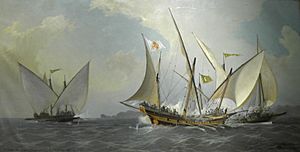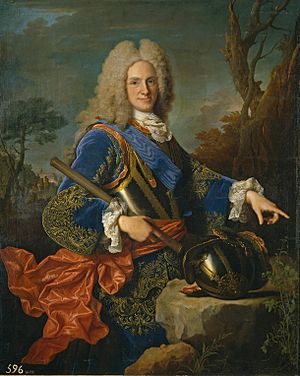Spanish conquest of Oran (1732) facts for kids
Quick facts for kids Spanish expedition to Oran |
|||||||
|---|---|---|---|---|---|---|---|
| Part of the Spanish-Barbary wars | |||||||
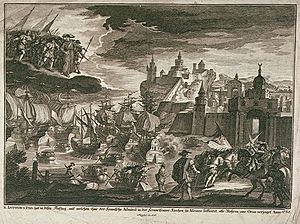 Spanish attack on Oran of 1732. |
|||||||
|
|||||||
| Belligerents | |||||||
|
|||||||
| Commanders and leaders | |||||||
| Strength | |||||||
| 27,000–28,000 men 12 ships of the line 50 frigates 7 galleys 26 galiots 4 brigs 97 xebecs Several gunboats and bomb vessels 109 transport ships Unknown minor vessels |
20,000 men Unknown number of ships |
||||||
| Casualties and losses | |||||||
| Unknown, but low | Heavy human and naval losses 142 pieces of artillery captured |
||||||
The Spanish conquest of Oran and Mers el-Kebir was a battle that happened from June 15 to July 2, 1732. It was fought between the Kingdom of Spain and the Deylik of Algiers, which was a state in North Africa.
A large Spanish army, led by Duke of Montemar and Francisco Javier Cornejo, defeated the Algerian forces. The Algerians were led by Mustapha Bouchelaghem, who was the Bey (ruler) of Oran, and Wali Hassan. Spain successfully took back the fortress-cities of Oran and Mers el-Kebir. These cities had been under Algerian control since 1708, when Bouchelaghem captured them during the War of the Spanish Succession.
Contents
Why Spain Attacked Oran
The cities of Oran and Mers el-Kebir in Africa were very important. Spain had controlled them since the early 1500s. However, in 1708, during the War of the Spanish Succession, the Bey of Oran, Bouchlaghem Bey, took them over. Spain was having a tough time with the war, so they lost control.
After the war ended, Spain became a strong European power again. King Philip V of Spain wanted to get these lost cities back. Part of the money for this trip came from a successful mission by Admiral Blas de Lezo. He made the city of Genoa pay Spain 2 million pesos. A large part of this money, 1.5 million pesos, was used for the new expedition.
Other European countries, like the Holy Roman Empire, worried that Spain wanted to take over their lands in Italy. To calm these fears, King Philip V announced that his goal was only to get Oran back.
Getting Ready for the Trip
The Spanish army started getting ready on March 16, 1732, in the port of Alicante, Spain. The Prince of Campo Florido was in charge of preparing everything. The city of Valencia was very busy with over 30,000 soldiers, sailors, and nobles. It was a big challenge to feed everyone, but they managed it well.
On June 7, Duke of Montemar, chosen by King Philip V to lead the trip, went to a convent to pray for success. By the end of May, the port was full of ships. All the transport ships nearby were ready. Everything was planned down to the smallest detail, and the expedition was set to sail.
The Spanish Fleet
The huge Spanish fleet was very impressive. It included 12 large warships, 50 frigates, 7 galleys, and 26 galiots. There were also 4 brigs, 97 xebecs, and many smaller gunboats and bomb vessels. About 109 transport ships carried supplies and soldiers. In total, there were around 500 to 600 ships.
The main commander of this fleet was the experienced naval officer Francisco Javier Cornejo. This fleet amazed everyone in Europe. As one writer from that time said, "Never before was the Mediterranean Sea covered in such a variety of flags."
The Spanish Army
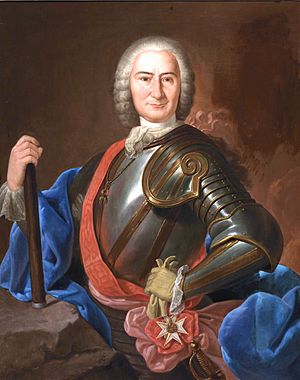
The army was led by the Duke of Montemar. It included 23 generals, 19 brigadiers, and 129 other officers.
The foot soldiers (infantry) had 32 battalions. This included an artillery battalion with 600 men and 60 cannons. Famous regiments like the Spanish and Walloon Guards were also part of it. There were also regiments from Ireland, Ulster, and Switzerland. In total, there were 23,100 infantry soldiers.
The horse soldiers (cavalry) had regiments like "Queen" and "Prince." There were also four regiments of Spanish Dragoons. In total, there were 3,372 cavalry soldiers.
The Journey to Oran

On June 15, 1732, all the soldiers were on board, and everything was ready. The fleet began to sail the next day in a perfect line, which was an amazing sight. A Spanish soldier and poet, Eugenio Gerardo Lobo, who was on the trip, wrote a poem about it.
A few days later, strong winds forced the fleet to stop near Cape Palos. But on June 24, they continued their journey towards Oran. On June 27, the fleet reached the coast of Oran. The Duke of Montemar ordered the troops to land on Aguadas beach, near Mers el-Kebir.
The landing happened the next day at dawn. The Spanish troops got off the ships with very little resistance. Algerian soldiers then started to attack. However, the powerful guns of the Spanish ships, especially the Castilla led by Don Juan José Navarro, helped a lot. Their cannons fired at the Algerian troops, making them run away. By midday, all the foot soldiers had landed, and the horse soldiers followed soon after.
Taking Oran and Mers el-Kebir
After midday, the grenadiers (special soldiers) and cavalry gathered on a small hill. This hill had the only fountain nearby, and the Spanish took control of it. The Algerians wanted to take it back. The Duke of Montemar ordered a small fort to be built there to keep a connection with the fleet.
A group of soldiers was set up to protect the workers building the fort. But they were constantly attacked by many Algerian troops. Because they ran out of bullets, the Spanish soldiers started to retreat. This made the Algerians feel brave, and they slowly moved forward.
Montemar saw this and sent 16 companies of foot soldiers and 4 groups of Spanish Dragoons to attack the Algerian front line. The Spanish attack was so strong that it caused many losses for the enemy. The Algerian troops were forced to run away to another mountain in great confusion. There were about 20,000 to 22,000 Algerian soldiers in total, including Janissaries and Turks.
The Spanish army kept moving forward until they reached Mers el-Kebir. There, they found a camp where the Janissaries had gathered. The Spanish quickly destroyed it, making about 300 Janissaries from Mers el-Kebir's army run away. The captain of the fort of Mers el-Kebir, Ben Dabiza, was scared by the strong Spanish gunfire. He gave up the fort, asking only that his men be allowed to go back to Algiers.
Right after, the Spanish army surrounded Mers el-Kebir. Montemar saw how successful this was. He then sent his army to the nearby mountains where most of the enemy soldiers were. But these Algerian soldiers were scared and had lost their courage. They ran away that very night to Oran. They also left behind all their forts and castles used for defense. The skill and discipline of the Spanish army clearly scared the Algerian troops.
The next day, July 1, Montemar heard from the French consul in Oran that the city was empty. He immediately sent soldiers to check. The news was true. The French consul himself came out to welcome the Spanish troops. They entered the city easily, as it was almost empty, including the Bey's Palace. The Spanish captured 80 bronze cannons, 50 iron cannons, and many other war supplies. There was enough to supply the city for at least three months. Finally, on July 2, the city of Mers el-Kebir also surrendered to the Spanish troops.
What Happened Next
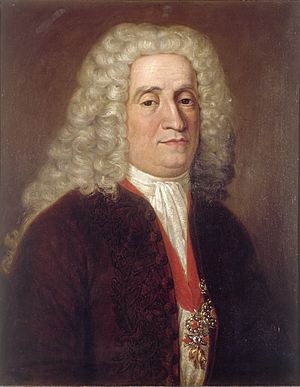
On July 5, a special religious ceremony called a Te Deum was held in Oran to celebrate the victory. The news quickly reached Spain and spread across Europe. Everyone celebrated this famous victory with parties and religious events. Pope Clement XII was very happy to hear that the cities were taken back. He thanked and praised Philip V of Spain.
About a month after Oran was taken back, on August 1, the city was secure. Montemar then returned to Spain with most of his soldiers, leaving 6,000 men to guard the city.
Montemar was welcomed with great excitement in Seville on August 15. King Philip V gave him a special award, a chain of the Order of the Golden Fleece. Don José Patiño also received the same honor because he had planned the expedition.
Bey Hassan did not want to give up his city. He regretted running away and tried many times to get it back. In late August, he attacked Oran with over 10,000 soldiers. But the Spanish defeated them, causing the Algerians more than 2,000 losses. Oran stayed under Spanish control until 1792.
See also
 In Spanish: Conquista española de Orán para niños
In Spanish: Conquista española de Orán para niños


